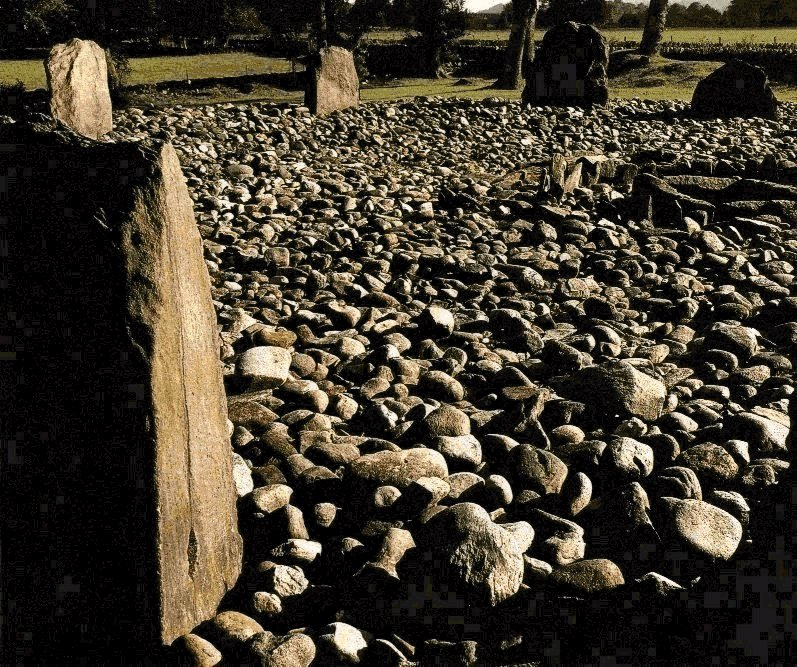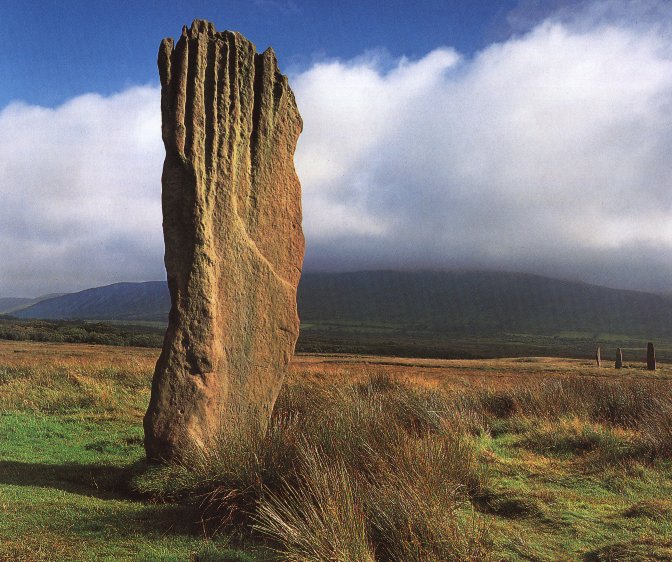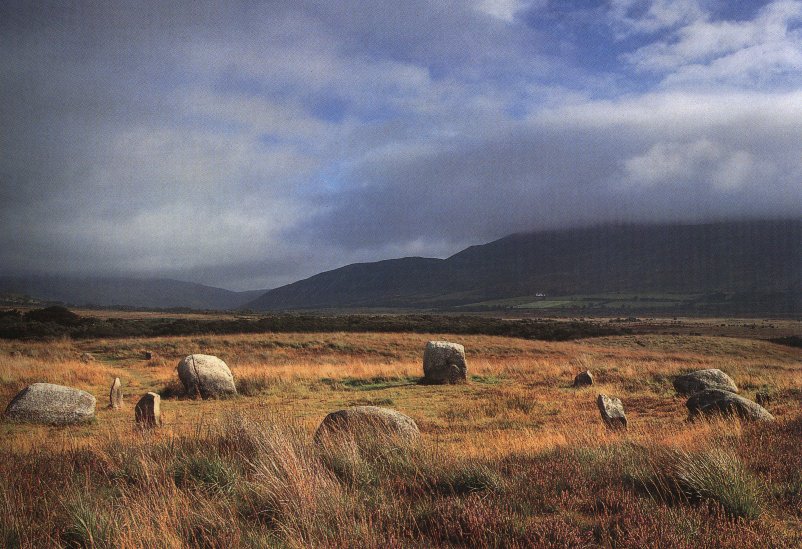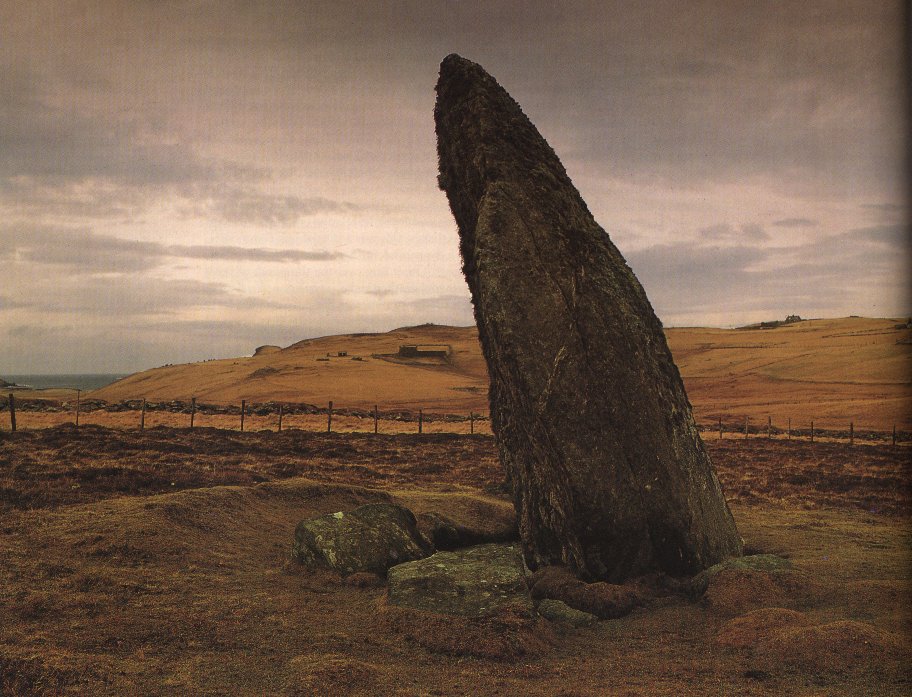

 Callanish on the Western coast of Lewis in the Outer Hebridies may be the oldest collection of monoliths in the British Isles. Overlooking Loch Roag this group of stones are a impressive site and can be seen for miles ( depending on the weather of course ) the flattened circle is 28 feet accross and contains 13 very large 'undressed' stones surrounding a small cist. A parallel line of stones 250 yards long leads up to the circle and a bit further and two smaller lines extend from the circle on the east & west so when seen from the air makes the shape of a celtic cross. It is beleived that individual stones in this group could be used to measure the exact position of the moon from one solstice to another. One legend tells us that thirteen giants who refused to convert to christianity were turned to stone by St.Keiran but christianity didn't exist when they were built!
Callanish on the Western coast of Lewis in the Outer Hebridies may be the oldest collection of monoliths in the British Isles. Overlooking Loch Roag this group of stones are a impressive site and can be seen for miles ( depending on the weather of course ) the flattened circle is 28 feet accross and contains 13 very large 'undressed' stones surrounding a small cist. A parallel line of stones 250 yards long leads up to the circle and a bit further and two smaller lines extend from the circle on the east & west so when seen from the air makes the shape of a celtic cross. It is beleived that individual stones in this group could be used to measure the exact position of the moon from one solstice to another. One legend tells us that thirteen giants who refused to convert to christianity were turned to stone by St.Keiran but christianity didn't exist when they were built!
 Kintraw this 13 foot standing stone marks a point between three small stone cairns, and one large, which are now ruins but were once covered in large white crystals, ruins of celtic buildings and stones marked with cup-and-ring-marks cover this area which was probably chosen because of the beautifull surroundings from which many small islands can be seen. The cup-and-ring-marks are found on standing stones monuments and uncovered rock and consist of cup shaped indents surrounded by broken or continuous circles have obviously taken a lot of time and effort to carve, similar patterns were common in the British isles and in southern Europe at around 2000 B.C. the standing stones and cairns also were erected at this time.
Kintraw this 13 foot standing stone marks a point between three small stone cairns, and one large, which are now ruins but were once covered in large white crystals, ruins of celtic buildings and stones marked with cup-and-ring-marks cover this area which was probably chosen because of the beautifull surroundings from which many small islands can be seen. The cup-and-ring-marks are found on standing stones monuments and uncovered rock and consist of cup shaped indents surrounded by broken or continuous circles have obviously taken a lot of time and effort to carve, similar patterns were common in the British isles and in southern Europe at around 2000 B.C. the standing stones and cairns also were erected at this time.
 Ballymeanoch is situated 5¼ miles N/W of Lochgilphead near Kilmartin dating between 2,000 B.C and 1,000 B.C is made up of three groups of stones , the first is a row of four stones going from North to south ,one of these stones is 12 feet high and has cup-and-ring markings carved on it, one other stone in this group also has these markings. The second group contains two stones and the third one stone which has now fallen that has cup-and-ring markings and is peirced .This site is on the southern side of "The valley of the dead" which contains Barrows and henge monuments.
Ballymeanoch is situated 5¼ miles N/W of Lochgilphead near Kilmartin dating between 2,000 B.C and 1,000 B.C is made up of three groups of stones , the first is a row of four stones going from North to south ,one of these stones is 12 feet high and has cup-and-ring markings carved on it, one other stone in this group also has these markings. The second group contains two stones and the third one stone which has now fallen that has cup-and-ring markings and is peirced .This site is on the southern side of "The valley of the dead" which contains Barrows and henge monuments.
 Temple Wood also in "The valley of the dead" consists of a perfect circle with thirteen stones , originally there were 20 stones and four large slabs in the middle which form a empty cist which in turn is surrounded by another smaller ring of stones. The cist once contained the bones of a child, a Beaker, and some flints, there are faint spiral carvings on the base of the most northerly stone. The burial sites in this area were in use for thousands of years and buried both the great and the not so great.
Temple Wood also in "The valley of the dead" consists of a perfect circle with thirteen stones , originally there were 20 stones and four large slabs in the middle which form a empty cist which in turn is surrounded by another smaller ring of stones. The cist once contained the bones of a child, a Beaker, and some flints, there are faint spiral carvings on the base of the most northerly stone. The burial sites in this area were in use for thousands of years and buried both the great and the not so great.
 Machrie moor on the island of Arran is the fantastic setting for these four incredible stones. Once part of two large stone circles which have been long since gone, the stone circle, which the stone in the foreground was part, has two stone cists (burial chambers)
in its centre one of which contained the skull of a young man and two arrow heads carved from flint .The stones date fron the late neolithic to early bronze age. The picture would have been very different at this time, the ground would have been fertile and the climate would have been better.
Machrie moor on the island of Arran is the fantastic setting for these four incredible stones. Once part of two large stone circles which have been long since gone, the stone circle, which the stone in the foreground was part, has two stone cists (burial chambers)
in its centre one of which contained the skull of a young man and two arrow heads carved from flint .The stones date fron the late neolithic to early bronze age. The picture would have been very different at this time, the ground would have been fertile and the climate would have been better.
 Machrie moor stone circle like the stones above an example of many different types of ceremonial features in this area ranging from the circles and stone tombs from neolithic times to hut circles and chambered cairns from around the bronze age .So as you can imagine this complex of sites holds a huge amount of mystery and who knows what still remains unseen under the lairs of peat that cover the area which were not in existence at the time this area was being used by the prehistoric community.
Machrie moor stone circle like the stones above an example of many different types of ceremonial features in this area ranging from the circles and stone tombs from neolithic times to hut circles and chambered cairns from around the bronze age .So as you can imagine this complex of sites holds a huge amount of mystery and who knows what still remains unseen under the lairs of peat that cover the area which were not in existence at the time this area was being used by the prehistoric community.
 Loch Buie stone circle is found on the island of Mull at the bottom of Ben Buie , the circle has two stones ont sall and one large that lie outside the circle these pointers align towards the midwinter sunset, being that it is in such a desolate and isolated area it is thought that this are could not sustain a large community and excavated burials suggest that men born in this time had about a 50% chance of dying before reaching the age of 36 while only 15% of women would be living after their 25th birthday!
Loch Buie stone circle is found on the island of Mull at the bottom of Ben Buie , the circle has two stones ont sall and one large that lie outside the circle these pointers align towards the midwinter sunset, being that it is in such a desolate and isolated area it is thought that this are could not sustain a large community and excavated burials suggest that men born in this time had about a 50% chance of dying before reaching the age of 36 while only 15% of women would be living after their 25th birthday!
 Bordastubble stone is on Unst the northernmost of the Shetland Islands and can be reached by rol-on roll-off ferry, these Islands have been home to britons, picts,and Vikings and this is reflected by the many different types of monument to be found all over these Islands, this stone 3.7 meters wide and 2.5 meters diameter is Gneiss stone and is perched far from a suitable outcrop of this stone so it begs the question why did the people go to so much effort to put it there? Was it a pointer for a walking route to a nearby cove or a land boundry or a religious symbol?. your guess is as good as the next persons.
Bordastubble stone is on Unst the northernmost of the Shetland Islands and can be reached by rol-on roll-off ferry, these Islands have been home to britons, picts,and Vikings and this is reflected by the many different types of monument to be found all over these Islands, this stone 3.7 meters wide and 2.5 meters diameter is Gneiss stone and is perched far from a suitable outcrop of this stone so it begs the question why did the people go to so much effort to put it there? Was it a pointer for a walking route to a nearby cove or a land boundry or a religious symbol?. your guess is as good as the next persons.